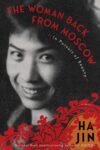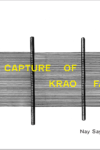
[New York Review Books; 2022]
Tr. from the Russian by Catherine Ciepiela
In 1941, shortly after occupying most of Europe, Nazi Germany broke its uneasy alliance with the Soviet Union and turned east. Within months, it had completely encircled a key target, the city of Leningrad—known before and after the Soviet era as St. Petersburg. It was a major port, the second-most prolific manufacturing hub after Moscow, and, as the capital of the Tsardom of Russia for more than two hundred years, an important cultural and political center. The siege of the city that followed lasted 872 days. This was one of the most brutal events of the war, claiming the lives of, by conservative estimates, about a million civilians, the great majority of whom starved to death during the first winter from 1941 to 1942.
As the poet Polina Barskova writes in her introduction to Written in the Dark: Five Poets in the Siege of Leningrad (Ugly Duckling Presse, 2016), “There is no dearth of cultural documentation of this historical disaster: from its very first day, the gruesome actuality of the Siege—corpses in the streets, incessant bombing and shelling, darkness, bitter cold, and most of all hunger—found representation in every literary form imaginable: journalistic sketch, epic narrative poem, novel, and even vaudeville. And of course, there was poetry.” Barskova is one of the eminent scholars of this documentation, especially its poetics, writing about the Siege and its inhabitants in a blistering corpus of scholarship, poetry, drama, and short prose, which together and from many angles interrogates how to represent an experience that defies representation.
Living Pictures, the latest work of hers to be made available in English, is composed mostly of short prose pieces and one eponymous short play or “fairy-tale document.” These fractured poem-stories are composed of disjunctively arranged images, slices of memory both personal and historical, and a shadowy array of citations of varying levels of obscurity and recognizability, creating unique prose tissues that carve out a space for themselves in an ambiguous zone between critical essay, autobiography, poetry, and short fiction. What is unambiguous is their success: They are extraordinarily powerful works, at turns densely evocative and dizzyingly erudite, doing many of the best things that writing can do. Barskova, following the method of her poetry, manages by painstaking technique and sheer force of image to ponder herself considering the Siege and its survivors, drawing from life and art to represent an experience of personal trauma mediated by communication with history.
Barskova, born in 1976 and raised in and around Leningrad, is preceded by the Siege by a little more than one generation. In a conversation with Valzhyna Mort, the translator of her 2021 poetry collection Air Raid, she describes encountering the Siege’s phantoms again and again as she was coming of age: “In that city, it’s virtually everywhere . . . for example, I spent my childhood in a little park called ‘Victory Park’: little did we know that during the Siege that whole place was an improvised ‘cemetery’ (meaning a ravine with emaciated dead bodies) and a crematorium. So, we played there, flirted there, right ‘above’ the ashes of those people, those children—and nobody told us.” In a sense, her project throughout her myriad works has been an excavation, towards something like those buried ashes.
A detailed, academic analysis of the cultural production of the Siege can be found in her 2016 Besieged Leningrad: Aesthetic Responses to Urban Disaster (Northern Illinois University Press), but a much more accessible point of entry is Written in the Dark, her compilation of the work of five poets writing in Leningrad during this period: Gennady Gor, Dmitry Maksimov, Sergey Rudakov, Vladimir Sterligov, and Pavel Zaltsman. Many of these poems, translated in this volume (by various contributing translators) into English for the first time, had remained hidden from the Russian-speaking public for nearly forty years.
Barskova presents these five as heirs to OBERIU, an avant-garde poetic movement active in Leningrad in the 20s and 30s. Barskova argues that the surrealist qualities of the OBERIU poets were expounded upon and strengthened by their Siege successors, though for very different reasons. Rather than challenging the notion of art as representative, surrealist poetics were called upon for “the paradoxical task . . . to represent, as faithfully and realistically as [possible], things that were seemingly impossible and unrepresentable . . . Indeed, striving towards a different notion of the real was one of OBERIU’s main creative missions. Their Siege successors, however, had no other choice: the situation in which they found themselves was already a different, non-normative reality.”
This is a key focus of Barskova’s own literary production as well, and especially of Living Pictures. For that reason, Written in the Dark is a great companion to Barskova’s poetry and creative writing, even something of a propaedeutic. Not only does Barskova’s writing have many thematic and technical concerns in common with that of the Siege poets—though, I should say, I find her poetry and short prose to be much better than most of the poetry in Written in the Dark—but she also references and quotes some of the OBERIU poets. An interesting case of this is a short, satirical poem by Pavel Zaltsman (1912–1985), which appears in Written in the Dark and is quoted in full in Living Pictures in a significantly different translation:
“Growl”
I’m a fool, I’m shit, I’m a wretch,
I’d kill any man for sausage.
But open up, please, let us in,
We’ve scratched like beasts for days on end.
I suffer, you hangmen, can’t you see
From urinary incontinency!
(From Written in the Dark, translated by Charles Swank and Matvei Yankelevich)
“Roo-Roo”
I’m stupid, I’m shit, I’m a cripple,
I’d kill a man for a tipple.
Let us in, we’re at the door,
We scrabble like wild dogs.
You butchers, I’m in pain
From awful bladder strain!
(From Living Pictures, translated by Catherine Ciepiela)
Reading these two volumes side-by-side produces a rare opportunity to read a poem in two translations, which, despite the silliness of this poem, is a worthwhile exercise, perhaps a gesture towards reassembling Walter Benjamin’s mythical vessel. Other opportunities for comparison abound between the two volumes, especially with Living Pictures‘ title piece, which features a journal literally written in the dark, in which “someone is writing as though he were blind[,] letters and words crawl[ing] on top of each other.” Another scene in “Living Pictures” features a creative expansion upon an anecdote from Zaltsman’s diaries. These are featured as an appendix to Written in the Dark, in which Zaltsman and his wife nearly die of exposure on a trip to an ornament store to buy a Christmas ornament during the first December of the siege, risking their lives for a droplet of normalcy in their otherwise upended world. The anecdote’s re-relation begins in “Living Pictures” with the introduction:
You know, someone I know told me a very strange story. It’s almost impossible to believe . . . He said he went to the store a few days ago to buy Christmas decorations! Imagine . . . He said the ridiculous urge remains . . . Those were his exact words, ‘ridiculous urge’—to buy Christmas decorations. His family—just like yours, Totlya—would always put up a bright, colorful Christmas tree, and now decorations belong to his memories and hopes, they’re a bridge to the past. . . . When they left the toys and went out into the night, they were nearly killed by the cold and the merciless onset of winter.
This instance is a great example of how Barskova, throughout her career, has used her historical research as the starting point for creative works, producing opportunities to breathe new, imaginative life into an archived past.
Sometimes the conversations with specific figures—from historical figures, to lesser-known Soviet poets, family and friends of hers, and otherwise unremembered people who left something behind—are so specific that a reader, without context, could perhaps find themselves a little lost, wondering what the significance of the Ulianov family is, for example. Detailed notes at the back of NYRB’s edition remedy this: “Soviet literature for young adults abounded in books about Vladimir Ilyich Lenin, whose actual surname was Ulianov.” Some of the endnotes also taxonomize the book’s parts, which at times I regretted. In different forms and editions, Living Pictures has been marketed as hitting different spots in the spectrum between fiction and nonfiction. For example, a press release for Air Raid produced in 2021 mentions Living Pictures, at the time forthcoming, as a “collection of creative nonfiction.” But both of the book’s English-language publishers, Pushkin in the UK and NYRB in the US, are currently marketing it as fiction. It is perhaps inevitable, if a little disappointing, to see the requirements of book market distribution do their reterritorializing work on such a population of wonderfully ambiguous writings. The stories-essays of Living Pictures move with liquid ease between subjects and modes of enunciation, from factual sentences about historical figures to poetic imaginations of their experiences, accounts of the narrator’s own experience, and reflections on the very process of such assemblages, in a way that necessarily evades such categorization. Take, for example, the following passage from “Persephone’s Grove,” the seventh item of the collection:
Hasten to me and be mine. I have to tell you, I’m completely unattractive now. His face with its refined features and rather beautiful eyes but repellent mouth and teeth, his white body with nothing growing on it, his small but shapely ass, later on we’ll talk about his other predilections. Tiresias, what have I become, what am I doing, how did I get here, what am I writing and with what?
Tiresias exhaled carefully: ‘I think this is prose. This text doesn’t break into phrases or even fragments. Something binds it very tightly. I also very much like—and this is incredibly difficult and rarely achieved—how the words seem like they’re fused with one another.’ Tiresias, after all, was a stylist. He taught you how to injure readers with iron words, how to delight them, how to make them become themselves—while keeping the voice firm and gentle. Then they will look at you like you’re the burning bush: you’ll see.
In these two paragraphs, we find a very clear example of key techniques of Barskova’s creative production: ambiguous citation and high fluidity of voice. “I’m completely unattractive now,” can be attributed to a letter written to the narrator three pages earlier; then, the narrator shifts back to her own voice and gestures outside of the text to another character’s assessment. Tiresias’s account, in my opinion, is quite spot-on, both of “Persephone’s Grove” and the other short writings of the collection. An example of Barskova’s prose that may better exemplify the binding quality he mentions, and her style for its own sake, is her vivid description of a scene from summer camp in “Modern Talking”:
The blinding light washes over small bright insect-shaped berries. You find them by feel. By groping. They stick out like hard, shiny, cheerful ticks on a dog’s belly. There are infinite amounts of berries here, blue-gray constellations receding into the dark underbrush. You grin at Tanya, your buddy in the junior Pioneer squad—at her blue lips, violet gums, purple tongue, teeth like black pearls.
Or the following image of a woman (Barskova’s narrator considering how to describe herself) grieving the loss of a lover while on a plane:
Describe the face of a woman howling, yes howling, in the plane’s womblike dark.
Her swollen face and the swollen dark. The woman next to me, such a nice woman, with nice lines on her lips, exhausted from choking down her cries, disappears and returns with cognac. She raises the nip and, sobbing, uses the fire to stamp out the icy bubble, and hic-hic-hiccups.
These are the other excavations of Living Pictures—of memory, both pleasant and painful. Throughout this work, Barskova digs through her own life in astounding harmony with her historical investigations, with just as much persistence to bring to life what may have previously been left unsaid.
While many, if not all, of these texts exhibit a self-consciousness about their textuality and flexibility of voice, the sort of explicit poioumena of the Tiresias scene is rare, although another example appears in “Persephone’s Grove”: “The writer [Isaac] Babel’s widow, an attractive iron lady subway builder, ideally lacking a sense of humor, tells us with surprise: ‘When I asked him why he writes stories with a nonfictional narrator, Babel said, ‘That way the stories can be shorter, since I don’t have to describe who the narrator is, what he’s wearing, where he’s been . . .’” That Barskova offers such a justification in a quote within a quote is very fitting. Babel’s nonfictional narrator resembles that of Barskova’s stories and adds credence to the publishing decision to market the entire volume as fiction, despite their ambiguity and resistance to categorization. “Fiction” here can act as a kind of umbrella term, within which one is more than welcome to write true facts of one’s own—and others’—lives but also may write more imaginatively, blending perspective and register for maximal poetic and emotional effects. For this reason, I was disappointed to learn from their footnotes that “The Forgiver” and “Ulianova in August,” two works in the collection that are just as daring and experimental as any, are “essays.” (“Persephone’s Grove” is more aptly called a “piece.”)
The most interesting taxonomizing label to be found in the footnotes is, of course, the one applied to the title piece: “Barskova created the genre term ‘fairy-tale document’ for her first play, [“Living Pictures”], which premiered in 2016 at the Theater of the Nation in Moscow and remains in its repertoire. The fairy-tale in question is Hans Christian Anderson’s story ‘The Snow Queen.’” “Living Pictures,” a short play of about thirty-five pages, is perhaps the piece in which Barskova most directly and solely treats the lived experience of the Siege, and the only one in which she or one of her avatars does not appear as a first-person narrator. Antonina (Totya) Izergina and Moisei Vakser, an art historian and visual artist respectively, are two of many employees of the Heritage Art Museum in Leningrad who hole up there during the bleakest months of the Siege, left behind even after the paintings have been evacuated. The play-fairy-tale document consists almost exclusively of their dialogue, as they wander through memory and imagination, alternating between hope and despair, love and revulsion, and their bodies are slowly destroyed by starvation, converting them into “dystrophics,” the word used during the Siege to refer to such victims.
At one point, when Totya is explaining to Moisei that she was giving tours of the empty frames where the paintings were hung for a visiting sailor in exchange for food (a bizarre scene based on real events, reported by various survivors of the Heritage museum), stage directions indicate that “Out of the darkness descend/appear picture frames. They glimmer with a dull, warm golden light. Each of the characters appears captured in a gleaming frame. Each begins his monologue in the ‘professional’ tone of a tour guide, at once ecstatic and robotic, and then gradually grows more animated, turns into a hybrid of himself and Rembrandt’s subject.” In the following monologues, Totya and Moisei transition from describing the pictures to living them. They become a more active version of the tableaux vivant from which the play-fairy-tale document and the collection take their names, a form of entertainment popular in the late nineteenth and early twentieth centuries in which actors would pose without moving, recreating famous works of art or scenes from history.
As they struggle to make meaning out of the absurdity and pain of their experience, Totya and Moisei’s fantastical possession by works of art might be read as a metonymic substitution for Barskova’s own multipronged method of approaching the Siege. On the one hand, she shifts when necessary from scholarship to poetry and other forms of creative writing, as though to understand the Siege’s victims and survivors by verbally acting out their experiences, living them. On the other, these creative explorations are dense with citations, constantly referring back to both the sources of the Siege and other artistic and philosophical encounters. We might remember Gilles Deleuze writing in “Postscript on the Societies of Control,” “There is no need to fear or hope, but only to look for new weapons.” In Barskova’s work, one will certainly not apply the first half of that suggestion, but one will recognize the second. One sees her reaching for new weapons not only at the level of each of her highly polyvocal individual poems and prose pieces but throughout the growing body of her writing available in English, as she passes from form to form.
Jack Rockwell is a writer and translator from Brooklyn, New York. His work is forthcoming or has appeared in Hopscotch Translation, Full Stop, Words Without Borders, Latin American Literature Today, Rust + Moth, Agora Mag, and more.
This post may contain affiliate links.







